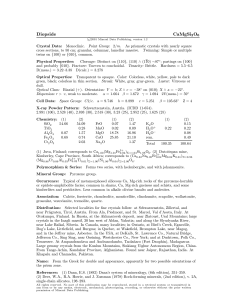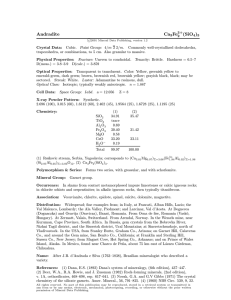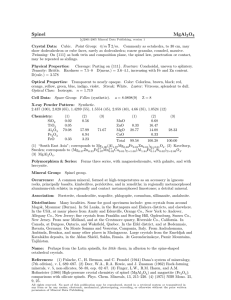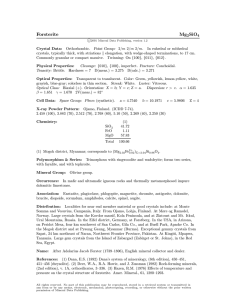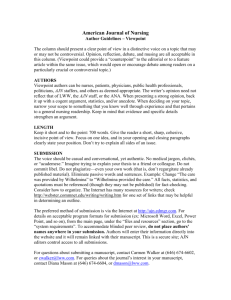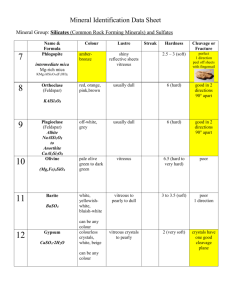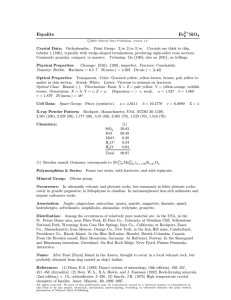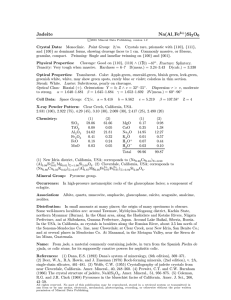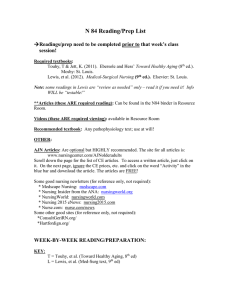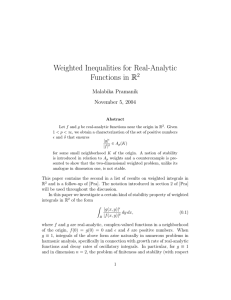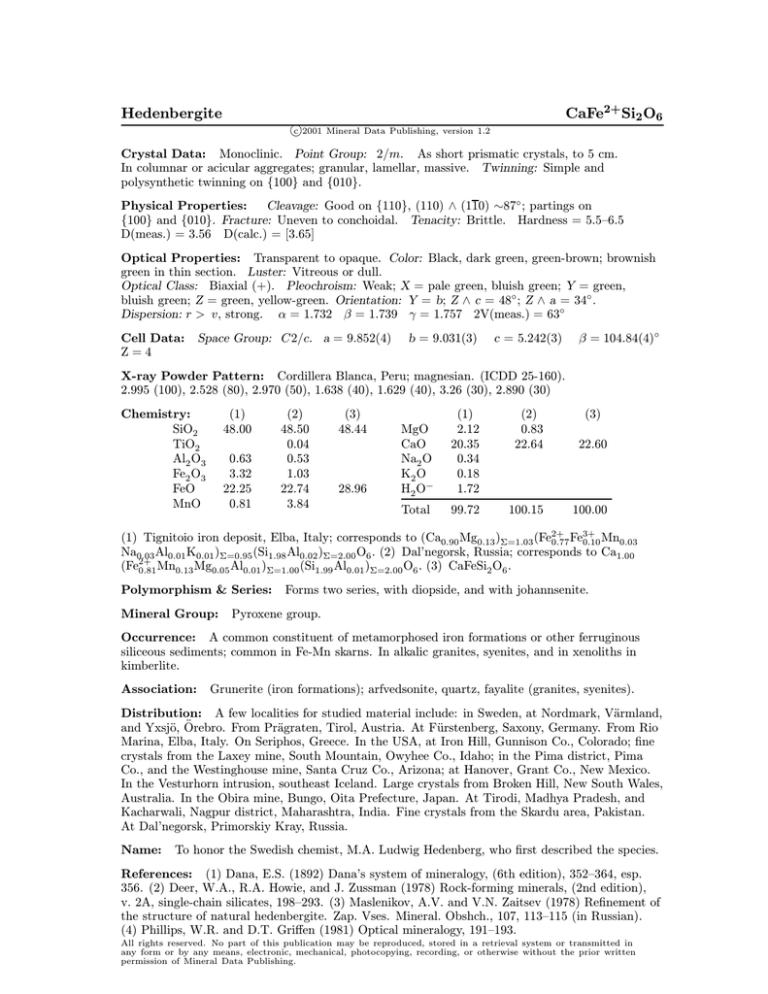
CaFe2+ Si2 O6
Hedenbergite
c 2001
°
Mineral Data Publishing, version 1.2
Crystal Data: Monoclinic. Point Group: 2=m: As short prismatic crystals, to 5 cm.
In columnar or acicular aggregates; granular, lamellar, massive. Twinning: Simple and
polysynthetic twinning on f100g and f010g.
Physical Properties:
Cleavage: Good on f110g, (110) ^ (110) »87± ; partings on
f100g and f010g. Fracture: Uneven to conchoidal. Tenacity: Brittle. Hardness = 5.5{6.5
D(meas.) = 3.56 D(calc.) = [3.65]
Optical Properties: Transparent to opaque. Color: Black, dark green, green-brown; brownish
green in thin section. Luster: Vitreous or dull.
Optical Class: Biaxial (+). Pleochroism: Weak; X = pale green, bluish green; Y = green,
bluish green; Z = green, yellow-green. Orientation: Y = b; Z ^ c = 48± ; Z ^ a = 34± .
Dispersion: r > v; strong. ® = 1.732 ¯ = 1.739 ° = 1.757 2V(meas.) = 63±
Cell Data:
Z=4
Space Group: C2=c: a = 9.852(4)
b = 9.031(3)
c = 5.242(3)
¯ = 104:84(4)±
X-ray Powder Pattern: Cordillera Blanca, Peru; magnesian. (ICDD 25-160).
2.995 (100), 2.528 (80), 2.970 (50), 1.638 (40), 1.629 (40), 3.26 (30), 2.890 (30)
Chemistry:
SiO2
TiO2
Al2 O3
Fe2 O3
FeO
MnO
(1)
48.00
0.63
3.32
22.25
0.81
(2)
48.50
0.04
0.53
1.03
22.74
3.84
(3)
48.44
28.96
MgO
CaO
Na2 O
K2 O
H2 O¡
(1)
2.12
20.35
0.34
0.18
1.72
(2)
0.83
22.64
(3)
22.60
Total
99.72
100.15
100.00
3+
(1) Tignitoio iron deposit, Elba, Italy; corresponds to (Ca0:90 Mg0:13 )§=1:03 (Fe2+
0:77 Fe0:10 Mn0:03
Na0:03 Al0:01 K0:01 )§=0:95 (Si1:98 Al0:02 )§=2:00 O6 : (2) Dal'negorsk, Russia; corresponds to Ca1:00
(Fe2+
0:81 Mn0:13 Mg0:05 Al0:01 )§=1:00 (Si1:99 Al0:01 )§=2:00 O6 : (3) CaFeSi2 O6 :
Polymorphism & Series:
Mineral Group:
Forms two series, with diopside, and with johannsenite.
Pyroxene group.
Occurrence: A common constituent of metamorphosed iron formations or other ferruginous
siliceous sediments; common in Fe-Mn skarns. In alkalic granites, syenites, and in xenoliths in
kimberlite.
Association:
Grunerite (iron formations); arfvedsonite, quartz, fayalite (granites, syenites).
Distribution: A few localities for studied material include: in Sweden, at Nordmark, VÄ
armland,
Ä
and YxsjÄo, Orebro.
From PrÄagraten, Tirol, Austria. At FÄ
urstenberg, Saxony, Germany. From Rio
Marina, Elba, Italy. On Seriphos, Greece. In the USA, at Iron Hill, Gunnison Co., Colorado; ¯ne
crystals from the Laxey mine, South Mountain, Owyhee Co., Idaho; in the Pima district, Pima
Co., and the Westinghouse mine, Santa Cruz Co., Arizona; at Hanover, Grant Co., New Mexico.
In the Vesturhorn intrusion, southeast Iceland. Large crystals from Broken Hill, New South Wales,
Australia. In the Obira mine, Bungo, Oita Prefecture, Japan. At Tirodi, Madhya Pradesh, and
Kacharwali, Nagpur district, Maharashtra, India. Fine crystals from the Skardu area, Pakistan.
At Dal'negorsk, Primorskiy Kray, Russia.
Name:
To honor the Swedish chemist, M.A. Ludwig Hedenberg, who ¯rst described the species.
References: (1) Dana, E.S. (1892) Dana's system of mineralogy, (6th edition), 352{364, esp.
356. (2) Deer, W.A., R.A. Howie, and J. Zussman (1978) Rock-forming minerals, (2nd edition),
v. 2A, single-chain silicates, 198{293. (3) Maslenikov, A.V. and V.N. Zaitsev (1978) Re¯nement of
the structure of natural hedenbergite. Zap. Vses. Mineral. Obshch., 107, 113{115 (in Russian).
(4) Phillips, W.R. and D.T. Gri®en (1981) Optical mineralogy, 191{193.
All rights reserved. No part of this publication may be reproduced, stored in a retrieval system or transmitted in
any form or by any means, electronic, mechanical, photocopying, recording, or otherwise without the prior written
permission of Mineral Data Publishing.

